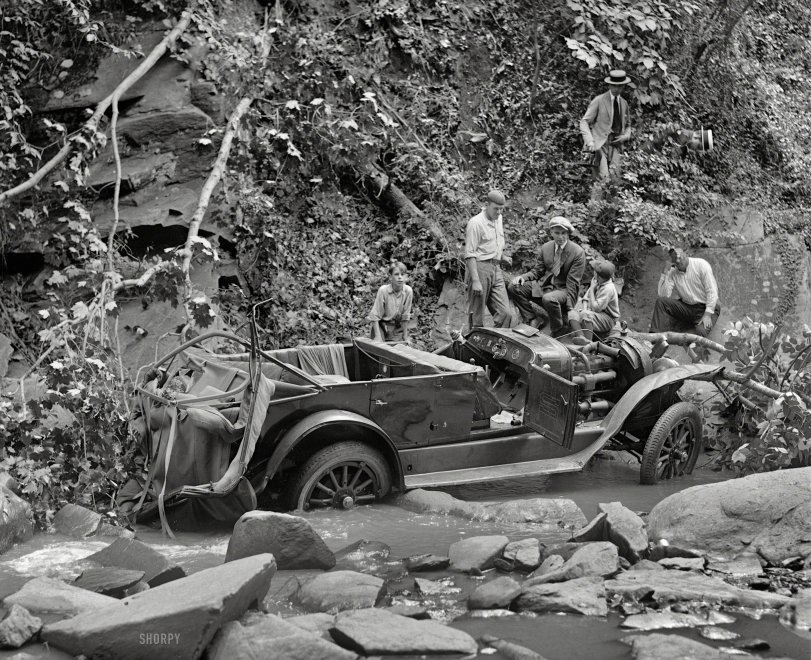


Framed or unframed, desk size to sofa size, printed by us in Arizona and Alabama since 2007. Explore now.
Shorpy is funded by you. Patreon contributors get an ad-free experience.
Learn more.

- I remember it well
- I can't prove it
- Complicated then, forgotten now
- Bryan-Stevenson
- Skinny is as skinny does
- How do you rest in peace
- Riding the footboards
- Alas, hidden from view
- Baldwin Diesels
- Exclusive pump
- Bananas, Oysters and Smokey Joe
- Details, Details
- What's that building to the left of the tower?
- Coal Barges
- Bromo-Seltzer
- Inner harbor
- The Basin
- What a headache!
- Giant stepladder?
- Yeah, it was cold
- Love those coats
- Link & Pin Days Remnant
- Baldwin 62303
- Baldwin VO-1000
- Cold
- No expense spared
- Tough Guys
- What's your hurry, where's your hat?
- Sheriff's Signature
- Relocated in the Eighties
Print Emporium
Over the Edge: 1923

Mrs. Dorothy Holland, 20 years old, of Baltimore, lies in Georgetown University Hospital suffering from internal hemorrhages as a result of an automobile in which she was riding going over a 30-foot embankment near the Virginia end of the Chain bridge at 6 o'clock yesterday morning. ... According to the police, the accident was the result of an all-night party that began at 1 o'clock yesterday morning ...
"Auto wreck -- July 30, 1923." Last seen here six years ago in this post. National Photo Company Collection glass negative. View full size.
Stephens Salient Six
From the book Minneapolis-Moline Farm Tractors by Chester Peterson, Jr. and Rod Beemer, MBI Publishing Company, Osceola, WI, Page 10
"George W. Stephens became president and controlling owner of MPC [Moline Plow Company] in 1882. Under his leadership, the company entered the automobile business in 1915, when it began building commercial bodies to go on Ford chassis. In 1916 the Stephens Motor Works at Freeport, Illinois, began production of MPC's passenger cars.
"The company's automobiles were named The Stephens Six and initially came in two models: the Model 65, which was a five-passenger touring design, and the Model 60, a roadster. In 1918 the new overhead valve six was introduced as the Salient Six and it, too, came in two styles: the three-passenger roadster, Model 70, and the Model 75, a five-passenger touring car.
"The Stephens Salient Six engine had been produced by Root & Vandervoort Company (R&V) of Moline, Illinois, since its first use in 1918. The MPC purchased the engine business of R&V late in 1920. At that time Moline was taking about 80 percent of this engine production for its tractors and Stephens autos.
"The medium-priced Stephens automobiles had much finer body work than was ordinarily seen in the trade. Between 1918 and 1924 several additional models were introduced. Yet on July 23, 1924, the company announced that it would cease production of the Stephens automobile. Total production of the Stephens auto is placed at approximately 30,0000 of which only 20 examples are known to exist."
Separately, the Chain Bridge, which the car was traveling upon, was the seventh bridge built in the same location. The first bridge collapsed; the second burned after six months; the third was destroyed by flood; the fourth was removed to build a new bridge; the fifth also collapsed; and the sixth was swept away during a flood. This seventh bridge lasted from 1874 - 1939. The current bridge is the eighth one built, but it is built upon the piers erected in the 1870s.
Ouch!
The broken steering wheel spokes and the rigid steering column could ruin your day very quickly on the ride down that embankment.
Collapsible steering column standards wouldn't be mandated in the U.S. until 1968 - forty-five years after this accident.
I'll bet
The jazz was hot at that party, though!
Stephens car
The spare tire cover seems to indicate that it's a Stephens. The S on the inside of the door hints this way also.
























On Shorpy:
Today’s Top 5